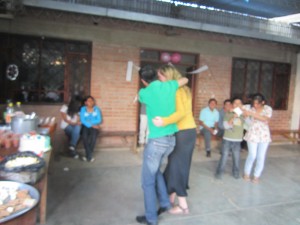I’m hesitant to analyze (read: attempt to analyze) anything political on the bloggy blog, for fear of totally misinterpreting and misinforming. However, the situation here in Bolivia is such that I felt obligated to write at least a bit about what’s been going on recently. I tried, I typed, I read many a BBC articles. And then I received this e-mail titled “An Open Letter To Our Friends About The Current Situation in Bolivia” written by Jim Shultz of The Democracy Center. Mr. Shultz has the words and the expertise that I lack, so I thought I’d pass on his letter to those of you who are willing to strap in and read it.
The Morales Presidency Takes an Ugly Turn
In 2005, Sacha Llorenti, the President of Bolivia’s National Human Rights Assembly, wrote a forward for our Democracy Center report on an incident here two years previously, known as ‘Febrero Negro’. The IMF had demanded that Bolivia tighten its economic belt and President Gonzalo Sanchez de Lozada complied by proposing a new tax on the poor. His action set off a wave of protest and government repression that left 34 people dead. Llorenti wrote of the government’s repression, “Those days refer to an institutional crisis, state violence, and her twin sister, impunity.”
Only months after Llorenti wrote those words, that era in Bolivia’s history seemed swept away in a wave of hope. The nation’s first indigenous President, Evo Morales, rode into power on a voter mandate unmatched in modern Bolivian history. He proclaimed a new Bolivia in which indigenous people would take their rightful place in the nation’s political life, human rights would be respected, and a new constitution would guarantee autonomy for communities ignored by the governments of the past. Overnight the people who had been attacked or ignored by Bolivia’s leaders suddenly became Bolivia’s leaders. Llorenti eventually rose to the most powerful appointed position in the nation, Minister of Government. The rays of optimism that spread out from Tiwanaku and La Paz extended worldwide and Morales become a global symbol of something hopeful.
It is a sad measure of how deeply things have changed that it was Llorenti himself who stepped behind the podium at the Presidential Palace last Monday to defend the Morales government’s violent repression of indigenous protesters on September 25th. Five hundred police armed with guns, batons and tear gas were sent to a remote roadside to break up the six-week-long march of indigenous families protesting Morales’ planned highway through the TIPNIS rainforest. Llorenti’s declarations echoed the tired justifications heard from so many governments before: “All the actions taken by the police had the objective of preventing conflicts and if cases of abuse have been committed they will be punished.”
Men, women and children marching to defend their lands were attacked with a barrage of tear gas, their leaders were beaten, women had bands of tape forcibly wrapped over their mouths – all under orders from a government that had promised to be theirs. How did it come to this?
The Highway Through the Rainforest
The indigenous families that were attacked by police on that Sunday left their lands in the TIPNIS on August 15th to march nearly 400 miles to their nation’s capital and press their case against the road that would cut through the heart of their lands. President Morales had made it very clear that he was not interested in hearing any more of their arguments against the mainly Brazil-financed highway. In June he declared, “Whether you like it or not, we are going to build this road.”
Morales argued that the highway was needed for “development,” creating new economic opportunities in parts of the country long isolated. In the name of those goals he was willing to ignore the requirements of community consultation and autonomy in the new Constitution that he had once championed. He was willing to abandon his own rhetoric to the world about protecting Mother Earth and to ignore studies about the likely destruction of the forest that the new highway would bring. What could have been a moment of authentic and valuable debate in Bolivia about what kind of development the nation really wanted instead became a series of presidential declarations and decrees.
As the march of some 1,000 people crept slowly onward toward La Paz its moral weight seem to grow with each step, drawing growing public attention that Morales couldn’t stop. The march became the lead story in the country’s daily papers every morning for weeks. Civic actions in support of the marchers grew in Bolivia’s major cities. More than sixty international environmental groups, led by Amazon Watch, signed a letter to Morales asking him to respect the marchers’ demands.
From Morales, however, each day only brought a new set of accusations aimed at stripping the marchers of their legitimacy. First, said the government, the march was the creation of the U.S. Embassy. Then the government declared that the marchers were the pawns of foreign and domestic NGOs. Last week while in New York for his speech to the U.N., the Morales entourage announced that it had evidence that it was former President Sanchez de Lozada who was behind the march. The litany of ever-changing charges began to sound something akin to a schoolboy scrambling to invent reasons for why he didn’t have his homework.
When the charges failed to derail the marchers’ support, the government and its supporters decided to try to steer them off their path to La Paz in other ways. They blocked the arrival of urgent donations of water, food, and medicine gathered and sent from throughout the country. But this only added yet again to the moral weight of humble people walking the long road to the capital.
Tear Gas at Dusk
Just after 5pm on Sunday, September 25, five hundred police dressed in full battle gear descended on the encampment (see video) where the marchers had pitched themselves for the night. Running at full speed they began firing canisters of toxic tear gas directly into the terrified groups of men, women, and children. Then the police began forcing them, screaming and crying, onto buses and into the backs of unmarked trucks for unknown destinations. Television footage captured the police knocking women to the ground and binding their mouths shut with tape. Many others ran to escape into the trees and fields so far from their homes. Children were separated from their parents.
Later that night those who had escaped the police began to take refuge in the small church of the town of San Borja. Early Monday morning government planes tried to land on an air strip in the town of Rurrenabaque, where more than 200 captured marchers were to be forcibly put aboard and returned to the villages where they had begun their trek so many weeks and miles before. The people in the community swarmed the runway to keep the planes from landing and were met with another attack of tear gas by the police sent there by the government.
Hours later the country’s young Defense Minister, Cecilia Chacon, announced her resignation. She wrote in a public letter to President Morales, “I can not defend or justify it [Sunday’s repression]. There are other alternatives in the framework of dialogue, respect for human rights, nonviolence, and defense of Mother Earth.”
She became the latest in a string of former Morales allies who had dramatically split from the government over the TIPNIS highway and the government’s abuses of the marchers. Morales’ former ambasador to the U.S., Gustavo Guzman, and the President’s former Vice-Minister for Land, Alejandro Almaraz, had not only left the government but also gone to join the marchers.
Over the course of the following Monday public denouncements poured out against the police attack on the marchers – from the National Public Ombudsman, the U.N., women’s groups, human rights groups, the Catholic Church, labor unions, and others, including many who had once been fervent Morales supporters.
By that Monday evening, with his public support in freefall, Morales finally spoke to the nation. He began by denying any involvement in Sunday’s police violence, blaming it on unnamed subordinates. But after years of arguing that his predecessors should be prosecuted for the abuses of soldiers and police under their command, it was a defense that convinced no one. Several key government officials told journalists that such an aggressive police action would never have taken place without orders from the government’s highest ranks.
Morales then announced that he would put the highway to a vote by the two Bolivian states, Cochabamba and Beni, through which the project would pass. Almaraz, the former Lands Vice-Minister, and others, quickly pointed out that such a referendum was unconstitutional, a direct violation of the provisions allowing local indigenous communities to decide the fates of their lands.
If Morales thought he had plugged the political leak in his weakened Presidency, it became clear Tuesday morning that the anger against him was only growing. Larger marches filled the streets in the cities of La Paz, Cochabamba, Santa Cruz and Sucre. The country’s labor federation (C.O.B) announced a strike. By nightfall the nation’s transportation workers announced that they too would stage a work stoppage Wednesday in opposition to the highway and in support of the marchers.
Just after 7pm Tuesday night Sacha Llorenti appeared at the Presidential Palace podium once again, this time to announce his own resignation. It appeared not so much an act of conscience, in the mold of Ms. Chacon’s the day before, but more a man being tossed overboard in the hope that it might afford the President some political protection.
Then Morales took to the airwaves to add an announcement of his own –
the temporary suspension of construction of the disputed road. But by early Wednesday news reports revealed that the Brazilian firm happily bulldozing the highway had received no such order.
A People Rising
Wednesday morning Evo Morales woke to a nation headed for a transit standstill, with new marchers headed to the streets, schools closed and a nation deeply angry with its President. The cheering crowds of his 2006 inaugural had become a distant memory.
What is behind Morales’ devotion to a road through the heart of the TIPNIS? Is he simply a stubborn believer in a vision of economic development filled with highways and factories, in the style of the North? Is it a matter of Presidential ego, of not wanting to make the call to his Brazilian counterpart (Brazil is both the financier and constructor of the road, and eager to gain access to the natural resources it would make accessible), admitting that he can’t deliver on a Presidential promise? Are his deepest supporters, the coca growers, so anxious for a road that will open up new lands for expanding their crop that Morales has been willing to push things this far? Only President Morales knows his true motivations. But what is a certainty is that he has paid an enormous political cost for sticking to them.
The events of the past week represent something new rising in Bolivia. The people – who have now listened to many Morales speeches about protecting the Earth and guaranteeing indigenous people control over their lands – have risen to defend those principles, even if their President has seemingly abandoned them. Ironically, Morales has now inspired a new environmental movement among the nation’s younger generation, not by his example but in battle with it.
In my interview with Sacha Llorenti for our report on Febrero Negro, he also told me something else. He told me that the 2003 repression was, “the moment in which the crisis of the country was stripped down to the point where you could see its bones.” Today in Bolivia a different crisis has laid bare a new set of political bones for all to see.
Evo Morales, in his global pulpit, had been an inspiring voice, especially on climate change and on challenging the excesses of the U.S. In Bolivia on economic matters he has often been true to the world, raising taxes on foreign oil companies and using some of those revenues to give school children a modest annual bonus for staying in the classroom.
But the abuses dealt out by the government against the people of the TIPNIS have knocked ‘Evo the icon’ off his pedestal in a way from which he will never fully recover, in Bolivia and globally. He seems now pretty much like any other politician. What has risen instead is a movement once again of the Bolivian people themselves – awake, mobilized, and courageous. The defense of Bolivia’s environment and indigenous people now rests in the hands, not of Presidential power, but people power – where real democracy must always reside.
…
Important note: Not to worry, oh family and friends far away. Though the marchers have been met with incredible violence and repression and though there is still so much progress to be made, I am safe as can be.










